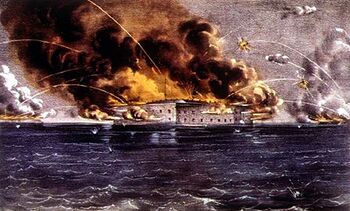Attack on Fort Edward
| Attack on Fort Edward | |||||||
|---|---|---|---|---|---|---|---|
| Part of Second Imperial-Balonic War | |||||||
 | |||||||
| |||||||
| Belligerents | |||||||
|
|
| ||||||
| Commanders and leaders | |||||||
|
|
| ||||||
| Strength | |||||||
| 134 | 900 | ||||||
| Casualties and losses | |||||||
| 1 Killed, 3 Wounded | 0 | ||||||
The Attack on Fort Edward, also known as the Battle of Fort Edward was the bombardment of Fort Edward in Gestoria Bay, West Oakcliffe by the Balonic Army, and the return gunfire and subsequent surrender by the Imperial Army garrison, that started the Second Imperial-Balonic War. With mounting tensions between the two nations, the Balonic government wished to weaken Vionna-Frankenlisch as much as possible before war was declared. Bradwater, the state capital of West Oakcliffe and a major port in northern Balion, was where a large portion of Imperial trade entered Balion. For forty years, Fort Edward had stood watch over Gestoria Bay under Imperial Army control to protect merchant shipping coming into Bradwater.
As tensions heightened, forces of the West Oakcliffe militia began to take up positions on the banks of Gestoria Bay and the situation began to seem like a siege. Lord Heatheridge in Vionna-Frankenlisch had enjoyed a relatively uneventful term as Prime Minister and the Fort Edward situation was his first challenge. The Imperial Navy tried to resupply the fort in January 1871 with the sloop-of-war HMNS Marienberg but it was fired upon by batteries on the Gestoria Bay banks. Gabriel H. Beauchamp, one of the first generals of the new Balonic Army, reinforced militia around Gestoria Bay and Bradwater with four hundred federal troops.
When Major John Pelham sent a message to Bradwater, explaining that he was expecting a supply ship from Vionna-Frankenlisch as the fort's situation was becoming dire. Upon receiving the message, General Beauchamp sent an ultimatum to Fort Edward, ordering the Fort to be evacuated and handed over to the West Oakcliffe authorities. Pelham refused on the eleventh of April and ordered the Fort's guns prepared. In the early morning of the twelfth, the Balonic forces opened fire on Fort Edward. The Fort's gunners tried to return fire but, severely outmatched, they were unable to cause any casualties, the Fort sustained four casualties when a gun exploded midway through the attack. The barrage was heavy and lasted from 4am to 6pm when the Balonic forces ran out of ammunition. Assuming the attackers were giving him a chance to surrender, Major Pelham ordered the fort's flag ran down and surrendered to General Beauchamp.
Background
Fort Edward, named after King Edward I of Vionna-Frankenlisch, had watched over Gestoria Bay for forty-one years to protect trade coming to and from Europa to Balion. The fort was commanded by Major John Pelham, an artillery officer from Lawrenceville. It usually had a garrison of three hundred men but at the time of the attack it was under half strength.
For two years, tensions had mounted between Vionna-Frankenlisch and Balion and the situation at Fort Edward was similarly tense. Resupply ships had tried to reach the fort but were scared off by Balonic batteries around Gestoria Bay, the sloop HMNS Marienberg being the last ship to attempt to run the gauntlet; she was seen off by heavy cannon fire from the West Oakliffe militia. Following this final attempt, Preston Marbrand, Governor of the Commonwealth of Oakliffe, ordered General Gabriel H. Beauchamp to reinforce the blockade of Fort Edward. Finally, on the 10th of April, Major Pelham sent a message to Bradwater, explaining the dire situation within the walls and that further supply ships were expected.
On the eleventh, General Beauchamp strengthened the blockade with fourteen cannons and four hundred federal soldiers, in addition to the five hundred men of the West Oakliffe Militia already there. He sent an envoy to the fort with an ultimatum, demanding the handover of the fort and promising the well-being of its garrison. It is still unknown whether or not this was sanctioned by Governor Marbrand, either of West Oakcliffe's senators or the president, or even at all.